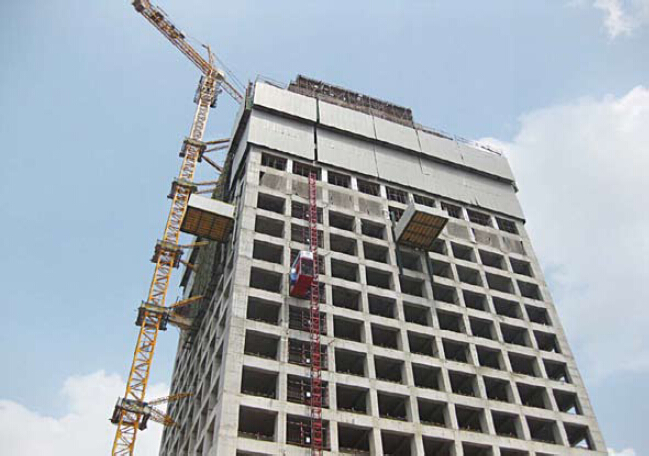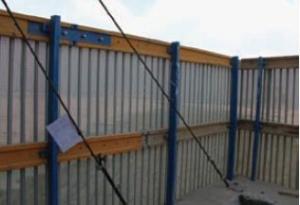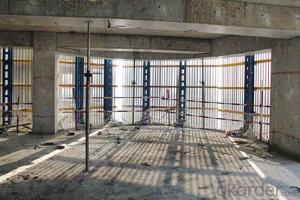Protection Platform for Formwork and Scaffolding Systems
- Loading Port:
- Tianjin
- Payment Terms:
- TT OR LC
- Min Order Qty:
- 50 m²
- Supply Capability:
- 1000 m²/month
OKorder Service Pledge
OKorder Financial Service
You Might Also Like
Protection Platform PP-50
A kind of new type construction protection system, applying operating platform and safer job
location for construction corps.
Characteristics:
◆ Easy and quick assembling.
◆ Lifted as a group, it is rapid and economic.
◆ Auto-climbing
◆ A safe and reliable anchor system
1. Composition
2. Assembly process of anchor system
(1) Embed V-climbing cone and anchor plate into the slab.
(2) Fix anchor shoe on the slab by tensile bolt.
(3) The fixed anchor shoe.
◆ High work efficiency with work platform and unload platform
◆ High light transmittance with the hollow block


- Q:How does steel formwork affect the overall construction site noise pollution?
- The overall construction site noise pollution can be significantly reduced by steel formwork. Steel formwork offers better acoustic insulation properties compared to traditional wooden formwork. The sound waves are absorbed and dampened by the rigid and dense nature of steel materials, resulting in minimized noise propagation. This is particularly advantageous in densely populated areas or construction sites near residential or commercial areas. In addition, steel formwork is commonly prefabricated, meaning it is manufactured off-site and then assembled on-site. This process reduces construction noise by requiring fewer on-site activities and decreasing the need for cutting, drilling, and hammering, which are major sources of noise pollution. Moreover, the use of steel formwork can lead to faster construction times, resulting in shorter exposure to noise for neighboring communities. Furthermore, steel formwork is more durable and long-lasting than wooden formwork, allowing it to be reused multiple times. This reusability reduces the frequency of formwork installation and dismantling, further decreasing noise pollution generated during the construction process. Overall, the utilization of steel formwork in construction can greatly contribute to the minimization of noise pollution at the construction site. The superior acoustic insulation properties, reduced on-site activities, and longer lifespan all collaborate to create a quieter and more environmentally friendly construction environment.
- Q:How does steel formwork handle different concrete pouring techniques?
- Steel formwork offers versatility and durability, making it an excellent option for various concrete pouring techniques. It possesses the strength and rigidity necessary to withstand the pressures exerted by different pouring methods, ensuring a stable and secure structure. One commonly used technique is gravity pouring, where concrete is poured into the formwork from above and allowed to flow downwards under its own weight. Steel formwork is highly suitable for this method as it effectively contains the concrete, preventing any leakage or spillage. The formwork's tight joints and sturdy panels ensure that the concrete remains in place and is evenly distributed throughout. Another technique is pumping, which involves using specialized equipment to pump concrete into the formwork. Steel formwork can handle this technique effectively, as it can withstand the force and pressure exerted during the pumping process. Its robust construction and reinforced edges provide the necessary support to contain the concrete and prevent any deformation or leakage. Steel formwork is also compatible with slip-forming, a technique that involves continuously pouring concrete into a moving formwork system. This method requires a formwork system that can be easily adjusted and adapted to changing shapes and heights. Steel formwork's modular design allows for quick and efficient adjustments, making it suitable for slip-forming applications. Additionally, its strength and stability ensure that the formwork remains intact during the continuous pouring process. In conclusion, steel formwork is a reliable choice for handling different concrete pouring techniques. Its strength, rigidity, and adaptability make it capable of withstanding the pressures and forces exerted by gravity pouring, pumping, and slip-forming methods. With steel formwork, builders and contractors can confidently execute various concrete pouring techniques, resulting in high-quality and structurally sound construction projects.
- Q:How does steel formwork affect the overall architectural aesthetics of the structure?
- Steel formwork can have a significant impact on the overall architectural aesthetics of a structure. The use of steel as a material for formwork can provide a sleek and modern appearance to the building. Its smooth and rigid surface allows for precise and clean lines, resulting in a more refined and elegant look. Steel formwork also offers great flexibility in terms of design possibilities. It can be easily shaped and molded into complex and intricate patterns, allowing architects to create unique and visually appealing structures. This versatility opens up a wide range of architectural possibilities, enabling the creation of buildings with distinct and eye-catching features. Furthermore, steel formwork provides a high level of structural stability, which enhances the overall aesthetics of the structure. The use of steel ensures that the formwork remains strong and sturdy, even under heavy loads, which is crucial for creating large and imposing architectural designs. The ability to use steel formwork in such constructions allows architects to achieve bold and impressive architectural forms that might not be possible with other materials. In addition to its visual impact, steel formwork also offers various practical advantages. It is a durable and long-lasting material that can withstand harsh weather conditions, making it suitable for both indoor and outdoor applications. Steel formwork is also highly resistant to fire, corrosion, and pests, further ensuring the longevity and integrity of the structure. Overall, steel formwork plays a crucial role in shaping the architectural aesthetics of a structure. Its smooth surface, flexibility in design, structural stability, and durability contribute to creating visually appealing and iconic buildings. By choosing steel formwork, architects can achieve both functional and aesthetic goals, resulting in structures that are not only beautiful but also reliable and long-lasting.
- Q:Are there any specific considerations for using steel formwork in areas with limited power supply?
- Yes, there are several specific considerations for using steel formwork in areas with limited power supply. Firstly, since steel formwork requires power tools for installation and removal, alternative methods such as manual labor or non-powered equipment may need to be employed. Additionally, the limited power supply may affect the availability of electricity for welding, which is often required for steel formwork assembly. Therefore, alternative joining methods such as bolting or mechanical fastening may need to be explored. Finally, the transportation and storage of steel formwork components in areas with limited power supply may require additional planning to ensure their accessibility and protection.
- Q:How does steel formwork accommodate openings and penetrations in the concrete?
- Steel formwork can accommodate openings and penetrations in the concrete by incorporating removable panels or cutouts in the formwork design. These panels can be easily removed or adjusted to create spaces for windows, doors, ducts, pipes, or any other required penetrations in the concrete structure. This flexibility allows for precise and efficient construction, ensuring that the concrete is poured accurately around the openings and penetrations, resulting in a well-structured and functional building.
- Q:What are the different types of supports used in steel formwork installation?
- Steel formwork installation commonly utilizes various types of supports to ensure stability and structural integrity. These supports are crucial for the formwork system, offering the following options: 1. Adjustable Props: These props effectively bear the weight of the formwork system and can be easily adjusted to the desired height. They provide stability during concrete pouring and curing. 2. Scaffolding: Frequently employed in steel formwork installation, scaffolding serves as a stable platform for workers. It allows easy assembly and disassembly, making it highly adaptable to different construction projects. 3. Beams and Girders: These horizontal supports distribute load evenly, preventing excessive deflection or deformation of the steel formwork. 4. Bracing: To maintain stability during concrete pouring and curing, diagonal supports known as bracing prevent lateral movement and secure the formwork in place. 5. Anchors and Tie Rods: Anchors and tie rods secure the formwork system to the existing structure, providing additional support and preventing movement or displacement during concrete pouring. 6. Wall Ties: Wall ties hold the formwork panels together, offering lateral support. Typically made of steel, they withstand concrete pressure during pouring and curing. 7. Wedges and Clamps: Wedges and clamps ensure a secure fit of the formwork panels, preventing concrete leakage during pouring. The appropriate selection of support for steel formwork installation depends on factors like structure size, complexity, load-bearing capacity, and site conditions. It is crucial to carefully consider these factors to ensure a safe and efficient formwork installation process.
- Q:How does steel formwork handle concrete curing additives?
- Steel formwork is highly resistant to the chemical reactions caused by concrete curing additives. It can withstand the corrosive effects of these additives, ensuring the structural integrity of the formwork during the curing process.
- Q:Can steel formwork be used for curved or complex shapes?
- Indeed, curved or complex shapes can be achieved using steel formwork. Steel, being a resilient and long-lasting material, can effortlessly be manipulated and molded to accommodate diverse designs. Its flexibility allows for the creation of intricate and personalized formwork systems suitable for a vast array of applications, including curved or complex shapes. The robustness and solidity of steel guarantee that the formwork remains steadfast throughout the pouring and setting of concrete, enabling meticulous and precise construction. Furthermore, the reusability of steel formwork proves to be an economical choice for projects necessitating curved or complex shapes.
- Q:Is steel formwork suitable for projects with limited access?
- Yes, steel formwork can be suitable for projects with limited access. Steel formwork is known for its high strength and durability, allowing it to withstand the challenges of a project with limited access. It can be easily transported and assembled in confined spaces, making it a favorable choice for projects where access is restricted. Additionally, steel formwork can be easily dismantled and reused, which is beneficial in limited access situations where materials need to be transported in and out efficiently. The flexibility and adaptability of steel formwork make it a viable option for projects with restricted access.
- Q:How does steel formwork differ from other types of formwork?
- Steel formwork differs from other types of formwork in several ways. Firstly, steel formwork is known for its durability and longevity. Unlike wooden or plastic formwork, which may require frequent replacements due to wear and tear, steel formwork can withstand heavy usage and can be reused multiple times. This makes it a cost-effective option in the long run, as it eliminates the need for constant formwork replacements. Additionally, steel formwork offers a higher level of precision and accuracy in construction. The rigid structure of steel formwork ensures that the concrete is poured and cured in the desired shape and dimensions. This is particularly important in projects that require high-quality finishes or complex architectural designs. Moreover, steel formwork provides excellent structural support. It can withstand the pressure exerted by wet concrete without deforming or collapsing, ensuring the stability and safety of the construction process. This is especially crucial in large-scale projects or in situations where high concrete volumes are involved. Furthermore, steel formwork is versatile and can be easily customized to meet specific project requirements. It can be easily assembled and disassembled, allowing for quick and efficient construction processes. Steel formwork can also be adjusted to accommodate different shapes and sizes, making it suitable for a wide range of construction projects. Lastly, steel formwork is highly resistant to weather conditions and environmental factors. Unlike wooden formwork, which may warp or deteriorate when exposed to moisture, steel formwork remains stable and unaffected by changes in temperature or humidity. This makes it suitable for both indoor and outdoor construction projects. In conclusion, steel formwork stands out from other types of formwork due to its durability, precision, structural support, versatility, and resilience to environmental factors. It offers numerous advantages that make it a preferred choice for many construction projects.
1. Manufacturer Overview |
|
|---|---|
| Location | |
| Year Established | |
| Annual Output Value | |
| Main Markets | |
| Company Certifications | |
2. Manufacturer Certificates |
|
|---|---|
| a) Certification Name | |
| Range | |
| Reference | |
| Validity Period | |
3. Manufacturer Capability |
|
|---|---|
| a)Trade Capacity | |
| Nearest Port | |
| Export Percentage | |
| No.of Employees in Trade Department | |
| Language Spoken: | |
| b)Factory Information | |
| Factory Size: | |
| No. of Production Lines | |
| Contract Manufacturing | |
| Product Price Range | |
Send your message to us
Protection Platform for Formwork and Scaffolding Systems
- Loading Port:
- Tianjin
- Payment Terms:
- TT OR LC
- Min Order Qty:
- 50 m²
- Supply Capability:
- 1000 m²/month
OKorder Service Pledge
OKorder Financial Service
Similar products
New products
Hot products
Related keywords
























